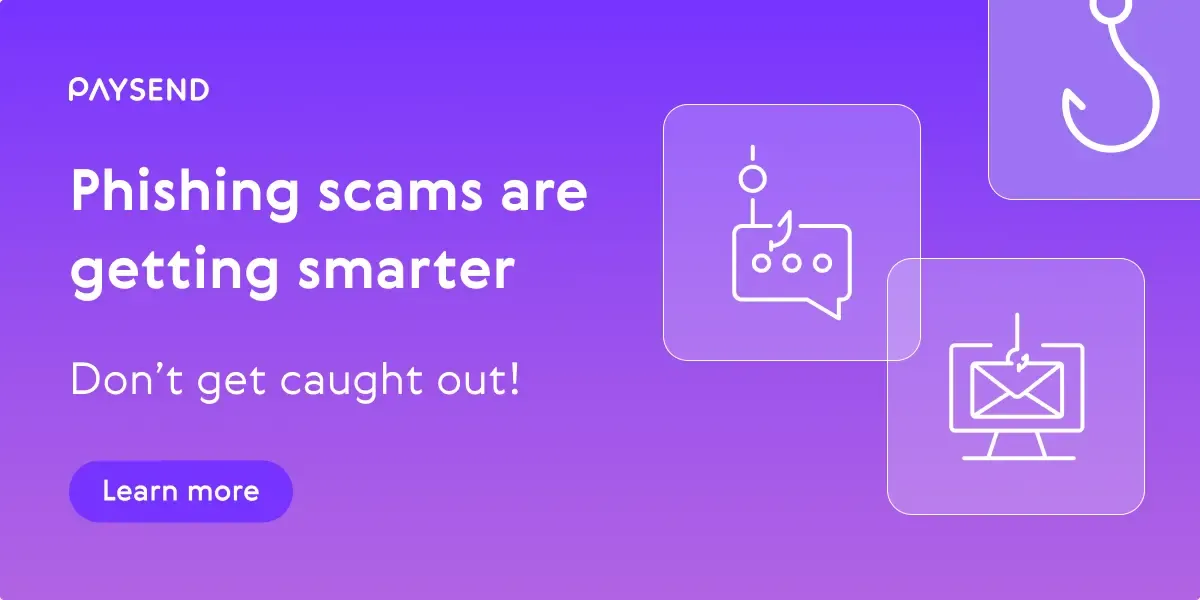How to protect yourself from phishing scam emails

We’ve seen an increase in fraudsters pretending to be Paysend in an attempt to trick our customers into revealing personal and financial details. These are known as phishing scams, and while we can’t stop people from impersonating us, we can help you stay protected.
Whether it’s an email, SMS, or social media message, phishing scams are designed to look convincing. But there are always clues. Here’s what you need to know to stay one step ahead.
What is a phishing scam email?
A phishing scam email is a fraudulent message that pretends to be from a trusted source – like a bank or a money transfer company – in order to steal personal data, such as your PIN, CVV, login credentials or bank card numbers.
These emails often:
- Look urgent (e.g. "your account is locked – click here now")
- Use fake domains or email addresses (e.g. [email protected])
- Include suspicious links or attachments
- Ask you to share OTPs or log in to a fake site
How to spot a fake Paysend message
Here are a few key rules to remember when checking whether a message really came from us:
- Our only website domain is paysend.com
- Customer Support will never call and ask for personal details or security codes
- If someone is urging you to act quickly or click a link — slow down and check
Always double-check the sender’s email address, especially for any unusual domains or typos.
What you can do to stay safe from phishing scams
If you’re not sure whether something is legitimate, follow these security best practices:
- Never share OTPs, CVVs or PIN codes with anyone
- Don’t click on suspicious links – instead, visit our site directly
- Enable 2-factor authentication for extra protection
- Only send money to people and businesses you know and trust
- Don’t install software someone asks you to download for “troubleshooting”
- Never give remote access to your phone, laptop, or Paysend account
What if you've already clicked?
If you think you may have fallen victim to a scam, take these steps immediately:
- Stop all communication with the suspected fraudster
- Contact your bank or card provider to report the breach
- Reach out to our Customer Support team via in-app chat or email at [email protected]
- Official ways to contact Paysend
To avoid confusion, here’s a list of our verified email addresses:
- [email protected]
- [email protected]
- [email protected]
- [email protected]
- [email protected]
- [email protected]
- [email protected]
You can also message us through the Help Center by clicking “Get help in the chat” at the bottom of any article.
Final tip: stay cautious
Scams evolve constantly — but so can your defenses. Bookmark this page, share it with anyone you know who uses Paysend, and take a moment to set up extra security today. Staying alert is the best protection.
The educational materials on this site are provided for informational purposes only and do not reflect the opinions of Central Bank of Kansas City, Member FDIC. Educational materials may contain links to content on third-party websites which are provided for your convenience; please note that linked sites may have a privacy and security policy different from our own, and we cannot attest to the accuracy of information. The Central Bank of Kansas City does not guarantee nor expressly endorse any particular business, product, service, or third-party content.
Latest Posts

We’ve seen an increase in fraudsters pretending to be Paysend in an attempt to trick our customers into revealing personal and financial details. These are known as phishing scams, and while we can’t stop people from impersonating us, we can help you stay protected.
Whether it’s an email, SMS, or social media message, phishing scams are designed to look convincing. But there are always clues. Here’s what you need to know to stay one step ahead.

Sending money to friends, family or business partners abroad should be quick, easy and affordable, right? But with traditional options - like trips to the bank, postal services or even outdated apps - it can feel like an uphill battle when needing to transfer money abroad.
You’re probably wondering how to transfer money internationally. Well, that's where Paysend comes in. We’re here to make international money transfers fast, secure, and easy.













